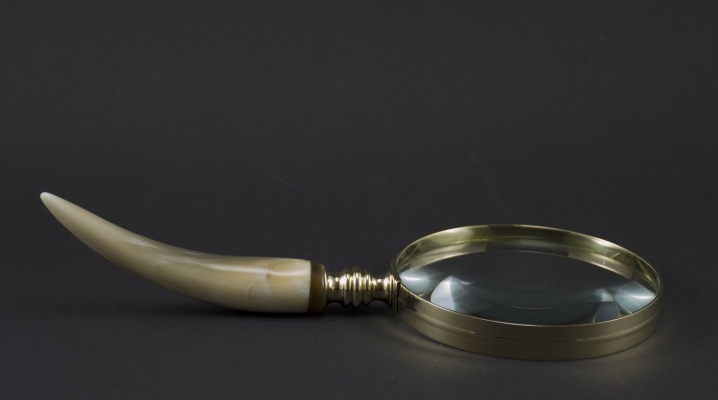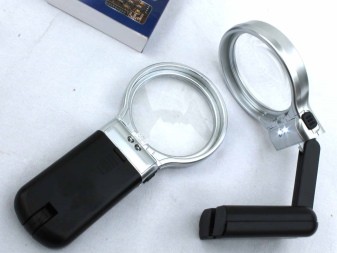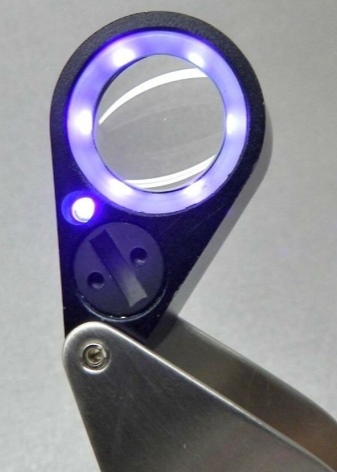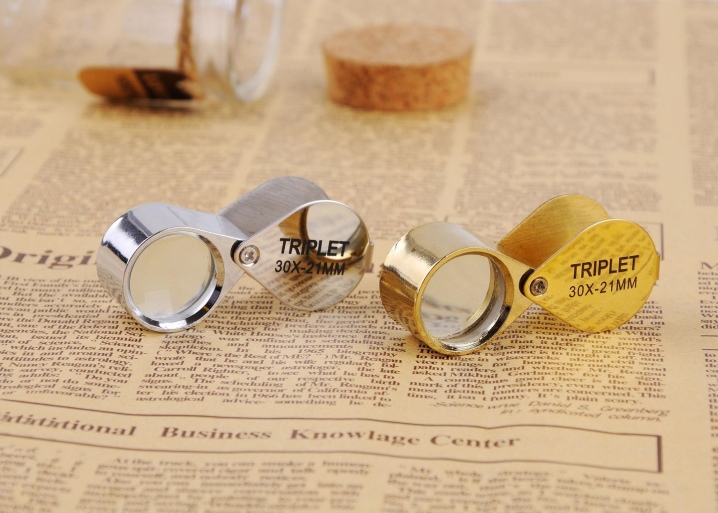Features of jewelry loupe

When working with antiques and various values, it is convenient to use a magnifying glass. It allows you to study the subject in detail and make sure of its authenticity. It is worth choosing a magnifier with special attention in order to achieve the highest quality image. A poor-quality device gives too much distortion and does not allow the jeweler to do his job comfortably.


Varieties
Jewelry loupe allows you to enlarge the image by 15-20 times. A 40-fold model is also possible, but it is only used when working with very small parts. Otherwise, the distortion is too great. Loupes can be divided into the following types.
- Portable. The models fit easily into a pocket and can be followed with the owner wherever they go. This is usually just a lens in a lightweight case.

- On a tripod. Stationary options can be carried within the same room, but it is hardly convenient to move around the city with them. Installed on the floor near the table.


- Ocular. They are also called foreheads, they resemble glasses. They can be made as a monocular with one lens. Particularly convenient to use.

- Tabletop. Installed directly on the work surface. Quite compact compared to tripod models. Usually these are lenses with a mid-level magnification.

With constructions, everything is as simple as possible. There are other classifications as well. Varieties depending on the type of optical system.
- Simple lens. The design has only one magnifying glass. Such models give a slight increase, so they are rarely used in jewelry.
- Double lens. Such devices are already able to correct color and work with small objects. The magnifier consists of two simple lenses that are not attached to each other.
- Doublet achromat. The design includes diffusing and collecting lenses. Models with impressive magnification are considered optimal for working with small jewelry.
- Triplet. For painstaking work, 3 lenses are provided at once. Distortion is minimized. Designed for work in which the utmost precision is required.


We should also highlight the presence or absence of backlighting. Additional light can be LED or fluorescent. The first one requires little energy, can function up to 50,000 hours on the same lamps and does not blink. Fluorescent light has better maintainability, but it works up to 20,000 hours.
It is worth noting that the backlight reduces eye strain when using the lens.


Manufacturers
A magnifier is a fairly simple instrument by design. At the same time, primitive models perfectly fulfill their rather complicated functions. It is because of this unusual combination of the simplicity of the mechanism and the complexity of the task that the manufacturer should be carefully considered. Firms that have already earned trust offer really high-quality products.
Deli, Prym, Satechi use quality materials in the manufacture of optical equipment. The structures are reliable and can withstand long years of operation. Manufacturers Armed, Lindner, Rexant, ReadMate offer a wide assortment with different technical characteristics.
Working with jewelry with a magnifying glass from these brands is comfortable and pleasant.


Criterias of choice
When choosing a magnifying glass, you should first of all start from what kind of work will be done with its help.For jewelers and watchmakers, slightly different models are needed, because the size of the parts to be dealt with is different. Important criteria to look out for.
- Multiplicity of approximation. The higher this indicator, the closer the picture and the smaller the viewing angle. For the needs of the watchmaker, an approximation of the order of 5-7x is quite enough, but for working with small jewelry - 10-15x.

- Design features. The lens plays a key role, but the case itself with the holder itself should be comfortable. For clock repair, it is optimal to use table and floor options. For small products, it is better to choose a model in the form of glasses, so as not to be distracted by a magnifying glass. True, with such a design it is convenient to study the characteristics of an object, but editing it may not be particularly comfortable.

- The presence of backlighting. This add-on allows you to keep working even in low light indoors. Compact models with LEDs are especially popular. In jewelry making, magnifiers with unusual UV or IR illuminations can be useful.

- Lens material. There are 3 main options: glass, plastic, polymer. Both cost and quality, duration of operation depend on this criterion. A plastic magnifier is the most affordable, but it scratches quickly. Glass is the most expensive, but it does not tolerate falls, serious mechanical stress. The best option is a polymer lens, which is the most popular.

Tips & Tricks
An hour or jewelry loupe should be not only of high quality, but also convenient. Additional accessories can be used to increase the comfort level at work. So, various clothespins and swivel tripods allow you to set the magnifier in the most convenient position. The optical device is positioned on the selected surface and fixed in the desired position.
Pay special attention to the backlit magnifier. It is important that the model is protected from scratches and light mechanical damage. Such a magnifier must be securely installed on the work surface or fixed to the hand.
It is especially convenient if the backlight is powered by rechargeable batteries. This allows you to work even where there is no way to connect to the mains.

The use of an illuminated magnifier greatly simplifies the work with small details. This model allows you to strain your eyes less. With the right choice, the design does not pose any problems at all. Care of the lens is as simple as possible, just clean it with a soft cloth to get rid of dust. It is important to protect the magnifier from drops, shocks and other mechanical impacts.

Levenhuk Gem jewelry loupes are presented below.













The comment was sent successfully.